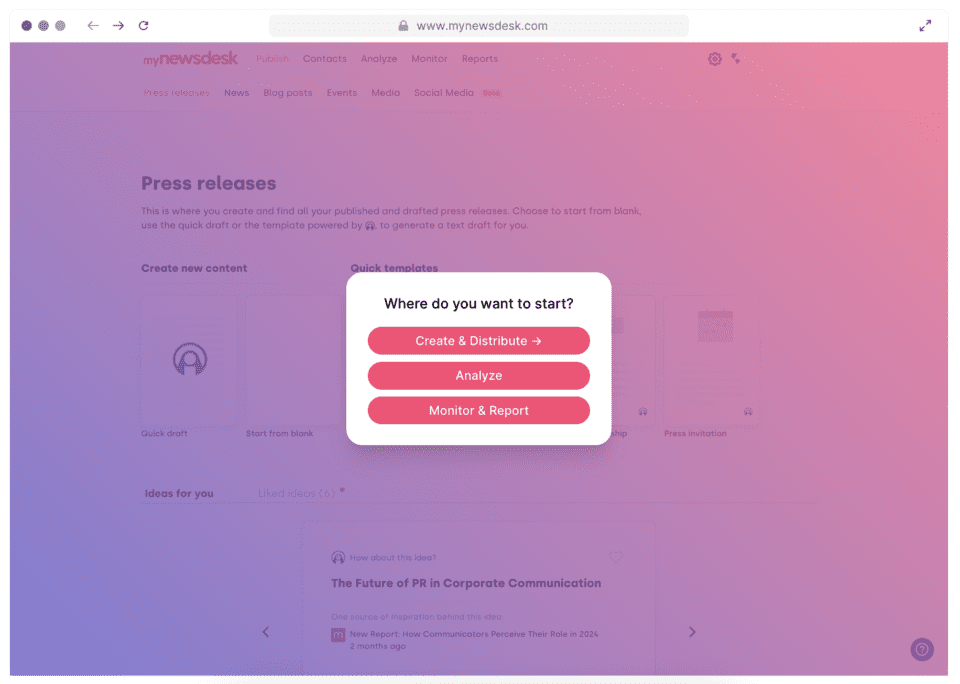Strategic Communications Plan | How to get started | 4 Experts & Template

Reaching a global audience has never been easier, but truly engaging them is more challenging than ever. With information overload and declining trust, communicators must step up their game. To guide you and help you succeed, we asked four experts for their top five strategies for creating an effective communications plan. Here’s what they shared.
Psst. Are you looking for a free PR and strategic communications plan template and guide? Download it here:
Download Free PR and Communications Plan Template & Guide
In 2018, UN Secretary-General António Guterres stated in his General Assembly speech:
“Our world is suffering from a bad case of Trust Deficit Disorder.”
He was referring to a global decline in trust toward governments, media, and businesses—driven by the rise of ‘fake news’ and ‘information fatigue.’ The 2020 Edelman Trust Barometer, which measures trust in institutions like governments, businesses, NGOs, and media, confirmed this trend.
Since then, the situation has worsened, and getting your message across can be more challenging than ever.
Yet, when done right, it can have a global impact within hours.
To explore how to create a successful PR and communications strategy in these times, we asked four experts from Scandinavia and Germany for their insights on what to say, how to say it, and what it takes to succeed.
Expert Tip #1: Start with Your ‘Why’—and Keep It Front and Center
Ask yourself: Which companies do I like, and why?
You’ll likely mention companies and brands that have a strong and clear sense of purpose.
With the pressure to deliver results quickly, it’s easy to lose sight of the purpose behind our actions. Always remember why you’re communicating and what you’re trying to achieve with your communication. This understanding is the foundation of a successful strategic plan, and what distinguishes communication from strategic communication.
While this is no news to you, it’s crucial to remember.
Helle Petersen, a communications advisor, researcher, and author of the aptly titled book Strategic Communication, based in Denmark, says:
“Strategic communication is simply communication that serves the purpose of helping you reach a certain goal. And these goals should always be connected to the overall strategic goals of the organization.”
Mala Wang-Naveen is the communications director for Sintef Digital, a Norwegian research institute that focuses on digital technologies. She describes strategic communication as the supporting wheels for the entire organization:
“You have these success criteria for your business or your organization, and a plan to get there. Your communication efforts, internal and external, should always aim to support that overall communication plan.”
“Your strategic communication goals must be connected to the organization’s overall strategic goals.”
Expert Tip #2: Prioritize Internal Communication First, Then External (Ensure Every Employee Communicates!)
When it comes to internal and external communications, our experts agree that a strong strategic communications plan addresses both aspects.
“The companies that succeed in their communication efforts are the ones where everyone communicates—and shares the same message. These companies foster a communication culture where everyone understands the vision and recognizes their important role in conveying it,” says Helle Petersen.
Unfortunately, she points out, this is often rare.
“Further down in the organization, employees rarely know what to communicate and why, simply because they have not been included. These individuals, who interact with customers and clients in stores or during customer service calls, are on the front lines and therefore extremely important ambassadors. Of course they should be an integral part of the company’s communication strategy, but most often they are not.”
Johanna Lindskog Lindell, the director of PR and corporate communications for home delivery giant Foodora in the Nordics, echoes Helle Petersen’s sentiments:
“It is crucial that everyone knows the goals—what we communicate and why. From the CEO down throughout the organization, we all need to be aligned. That’s how our communication can support the business. Thanks to strong internal channels, we can reach our 2,500 employees with information in seconds. That is an important possibility.”
Here’s the Most Important Role of Your Communications Team
Helle Petersen emphasizes that it is up to leadership to ensure every employee can become a communicator:
“Every leader in an organization needs to ensure that their employees are well-informed and engaged in ongoing dialogue about relevant strategic issues. Research shows that the immediate manager is the most important communication channel, and so the role of the communications department is not just to communicate, but to make sure everyone else communicates.”

Expert Tip #3: Be Authentic, Communicate Honestly, and Boldly Stand for Your Something
“We live in a trust economy, where trust is a currency of its own. People now, perhaps more than ever, want to interact with companies and organizations they can trust. This is true whether your business is to collect data or sell hamburgers,” says Mala Wang-Naveen.
To build trust, you need to tell the truth, but you also have to demonstrate that consumers can trust your company to do the right thing. According to Johanna Lindskog Lindell, this expectation has grown in importance.
“The value of being authentic is not something new, but I do think that the pandemic has accelerated it and made it all the more important. As a consumer, you want to support the companies that you think share your values.”
“Your actions speak louder than words. If you want to earn loyalty from customers, you need to truly deserve it. Over and over again.”
Mala Wang-Naveen agrees.
“You have to come across as authentic, and since you can’t fool people, that means you need to be authentic. The world today can seem dark and frightening, and consumers won’t listen to companies that only want to sell stuff. You have to do things that actually matter, you need to be their friend.”
Consumers won’t listen to companies that only want to sell stuff. You need to be their friend.
And, as Helle Petersen adds, you won’t appear authentic if your communication lacks consistency.
“There are so many communication channels—both online and offline, in stores, etc. Everyone, including the immediate manager, needs to know your main message across all these channels. Achieving success requires a strong focus on internal leadership communication.”
The Key to Loyalty: Strong Positioning and a Clear Focus
Jens Bohl serves as the press spokesperson for Sky Broadcasting Company in Germany. He notes that as the world becomes increasingly digital, the need to forge strong connections with customers becomes more important.
“Today, it’s easy for customers to provide negative feedback via social media, and flexible streaming options make it easy to quit or unsubscribe. As competition and the number of alternatives to choose from increase, it’s important to have a strong product that stands out—and to push sales efforts through focused communication activities. Building loyalty with long-term customers is also what might save you in a crisis.”
Push sales efforts through focused communication activities.
Psst. Want to simplify and improve your strategic communications and PR efforts? Mynewsdesk is the #1 rated PR software in the Nordics for user experience – explore it here.
Expert Tip #4: Be Flexible and Prepare for Crises
While companies aiming to stay ahead recognize the value of viral content, they are also acutely aware of how quickly marketing mistakes and negative press can spread.
According to Johanna Lindskog Lindell, this risk must be incorporated into a company’s strategic communications plan.
“And even more so today than a few years back. Then, many companies would enlist outside expertise when faced with a PR nightmare, but today, this needs to be part of your strategy and in-house expertise. Things move a lot faster now, and so should you.”
Being quick and flexible isn’t just important during a crisis. If you ask Jens Bohl, it should be a fundamental aspect of your communications strategy. He recalls the COVID pandemic:
“In January of 2020, we had no idea of the challenges we would face. No one could have known, but the companies that coped best were the ones with built-in flexibility in how they operate and communicate. You need to be flexible—not just because of the risk of a pandemic, but also because of how fast things are changing in general—and because disruptions happen all the time.”
Johanna Lindskog Lindell agrees, noting that this is why she is not a fan of communication plans in the first place.
“Communication plans tend to be static, but today, you must be dynamic in your communication. I have overarching goals in my communication plan, but the path to achieve them can change overnight.”
Expert Tip #5: Be Relevant and Measure Everything—How to Engage When Interest Is Low
“I firmly believe in the power of conversation; that we must produce content that touches people—content that starts a dialogue. And while many companies might know this, it doesn’t mean they’re good at it,” says Mala Wang-Naveen.
So, how can you excel at it? Jens Bohl emphasizes that it’s all about staying relevant.
“You have to choose the right topic for the right audience and communicate your story through the right channels for that specific audience. Moreover, you need to ensure that your message is clear and that you find the right balance in its distribution. Because even if you get everything right, a good message can easily be weakened by too large a dose.”
Johanna Lindskog Lindell explains how Foodora uses data to optimize these parameters—amplifying what’s working and adjusting what’s not effective.
“We are a data-driven company, allowing us to measure our customers’ needs in real time. We know when they want faster deliveries, what they want to eat, and what they want to buy. A big part of our job is to listen to that data and act on it fast, because it changes all the time.”
A big part of our job is to listen to the data and act on it fast.
Summary: Kickstarting Your PR and Strategic Communications Plan
Creating an effective strategic communications plan is essential for your business to succeed.
This blog post highlights five insights from four experts on key strategies for successful communication:
- Start with Your ‘Why’: Always clarify the purpose behind your communication efforts.
- Prioritize Internal Communication: Ensure that every employee understands and communicates the organization’s goals.
- Be Authentic and Boldly Stand for Something: Build trust by always being honest and transparent in your messaging.
- Be Flexible and Prepare for Crises: Adapt your communication activities quickly to changing circumstances and incorporate real-time feedback.
- Stay Relevant and Measure Everything: Focus on delivering content that is valuable for your audience and measure its impact.
This is the secret formula.
By implementing these strategies, your organization can effectively connect with your audiences and foster meaningful engagement that ultimately leads to increased customer acquisition and loyalty.
For proof of concept, consider putting on your consumer hat and asking yourself, again: Which companies do I like, and why?
Take your PR to the next level – try Mynewsdesk for free!
Helle Petersen is a communications advisor and researcher, and author of the book ‘Strategic Communication’. www.hellepetersen.dk
Mala Wang-Naveen is the communications director for Sintef Digital, a Norwegian research institute focused on digital technologies.
Jens Bohl is the press spokesperson at Sky Broadcasting Company in Germany.
Johanna Lindskog Lindell is the director of PR and corporate communications for Foodora in the Nordics.

